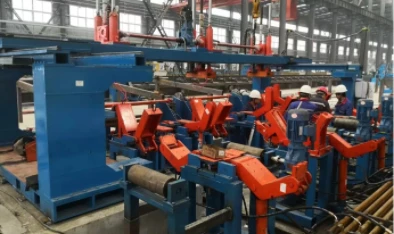roll formed steel shapes
Exploring Roll-Formed Steel Shapes A Key Component in Modern Construction
Roll-formed steel shapes play a critical role in today’s construction and manufacturing industries. This innovative process utilizes continuous metal sheets, which are shaped into various profiles through a series of rollers, providing significant benefits in terms of efficiency, strength, and versatility.
The Roll-Forming Process
The roll-forming process begins with flat strips of steel that are fed into a set of rollers. These rollers are specifically engineered to gradually bend and shape the steel into desired profiles, transforming flat metal into complex cross-sections without compromising the structural integrity of the material. This method is highly efficient, capable of producing long lengths of uniform shapes at high speeds, which makes it ideal for large-scale projects.
One of the key advantages of roll forming is that it minimizes material waste. Because the process involves shaping rather than cutting, significantly more material can be utilized. Additionally, the continuous nature of the process allows manufacturers to produce pieces with consistent quality and dimensions, which is vital in construction applications.
Applications of Roll-Formed Steel Shapes
Roll-formed steel shapes are widely used across various sectors, including commercial construction, industrial applications, and automotive manufacturing. Common profiles include channels, angles, U-shaped, Z-shaped, and custom designs tailored to specific needs. These shapes are essential for structural support, framing, and architectural features in buildings.
In commercial construction, roll-formed steel is often used for purlins and girts, which are integral components in supporting the roof and walls of steel buildings. The strength-to-weight ratio of roll-formed steel makes it an excellent choice, ensuring that structures are both strong and lightweight. This is particularly beneficial in reducing overall material costs and construction timelines.
roll formed steel shapes

In addition to structural applications, roll-formed steel shapes are also prevalent in the manufacturing of consumer products, such as appliances, furniture, and automotive parts. For instance, the car industry relies heavily on roll-formed components for framing, reinforcing, and various other assemblies that require precision and durability.
Benefits of Roll-Formed Steel Shapes
One of the most significant benefits of using roll-formed steel shapes is their inherent strength and durability. Steel is renowned for its ability to withstand various stresses and strains, making it an ideal material for load-bearing applications. The continuous nature of the roll-forming process enhances the mechanical properties of the steel, further improving its performance under load.
Moreover, roll-formed shapes can be treated with various coatings to enhance corrosion resistance, making them suitable for outdoor applications where environmental exposure is a concern. The ability to customize shapes and sizes also allows architects and engineers greater flexibility in design, facilitating innovative solutions that meet specific project requirements.
Environmental Considerations
As sustainability becomes an increasingly important consideration in construction, roll-formed steel shapes offer a more environmentally friendly option. Steel is 100% recyclable, and utilizing roll-forming technology reduces material waste and energy consumption compared to traditional manufacturing methods. By opting for roll-formed steel, companies can contribute to a more sustainable future while still meeting the demands of modern construction.
Conclusion
In conclusion, roll-formed steel shapes are a vital component of contemporary construction and manufacturing, offering numerous advantages such as efficiency, durability, and versatility. As industries continue to pursue innovative and sustainable practices, the role of roll-formed steel is likely to expand even further. With its ability to support a wide range of applications while minimizing environmental impact, roll-formed steel shapes will undeniably remain at the forefront of structural engineering and design. Whether in commercial buildings, industrial facilities, or consumer products, the contribution of roll-formed steel shapes to the construction landscape is both significant and enduring.
-
High Frequency Straight Seam Welded Pipe Production Line|BzZhou Xinghua|Precision Welding&EfficiencyNewsJul.30,2025
-
High Frequency Straight Seam Welded Pipe Production Line - BzZhou Xinghua|Precision Engineering&EfficiencyNewsJul.30,2025
-
High-Frequency Straight Seam Welded Pipe Production Line-BzZhou Xinghua Machinery Equipment Manufacturing Co., LTD.NewsJul.30,2025
-
High-Frequency Straight Seam Welded Pipe Production Line-BzZhou Xinghua Machinery Equipment Manufacturing Co., LTD.|Precision Manufacturing, High EfficiencyNewsJul.30,2025
-
High Frequency Straight Seam Welded Pipe Production Line-BzZhou Xinghua Machinery Equipment Manufacturing Co., LTD.|Precision Steel Pipe Manufacturing&Industrial EfficiencyNewsJul.29,2025
-
High-Frequency Straight Seam Welded Pipe Production Line-BzZhou Xinghua Machinery Equipment Manufacturing Co., LTD.|Precision Steel Pipe Manufacturing&Industrial EfficiencyNewsJul.29,2025


